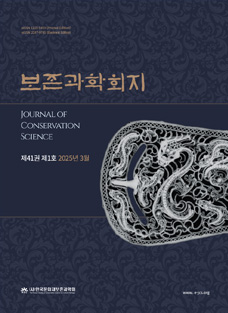Journal of Conservation Science Vol.25 No.3 pp.255-271
기흥 농서리유적 출토 토기의 재료과학적 특성과 소성온도 해석
Interpretation of Firing Temperature and Material Characteristics of the Potteries Excavated from the Nongseori Site in Giheung, Korea
Ran Hui Gim,Sun Myeong Lee,So Young Jang,Chan Hee Lee
Abstract
This study was examined interpretation of making techniques and provenance interpretation of raw materials for the potteries from the Nongseori site in Giheung based on archaeometric characteristics. The potteries are classified into three groups according to the archaeological age. The texture of Neolithic age potteries is sandy soil added a lot of temper such as talc and mica, and Bronze age potteries contain sandy materials which occur naturally include quartz, orthoclase, plagioclase and mica. On the other hand, Proto-three Kingdom Age potteries made of silty soil that sift out coarse minerals from the clay. But all pottery and soil samples in the study were very similar patterns with geochemical evolution trend. This result is sufficient evidence that all pottery samples were produced using the same raw materials from the host rocks around of the site area. The Neolithic age potteries had loose texture and fired probably about 700 to 760℃. The Bronze age potteries had experienced firing about 850 to 900℃. And Proto-three Kingdom Age potteries had compact textured and fired from 900 to 1,050℃. The making techniques of potteries are not represented discontinuation characteristics about the periodic time sequences, and are suggested that revealed a transitional change patterns for production techniques.

 E-Submission
E-Submission 
 E-Submission
E-Submission 
![]() Journal Search Engine
Journal Search Engine




 KSC
KSC